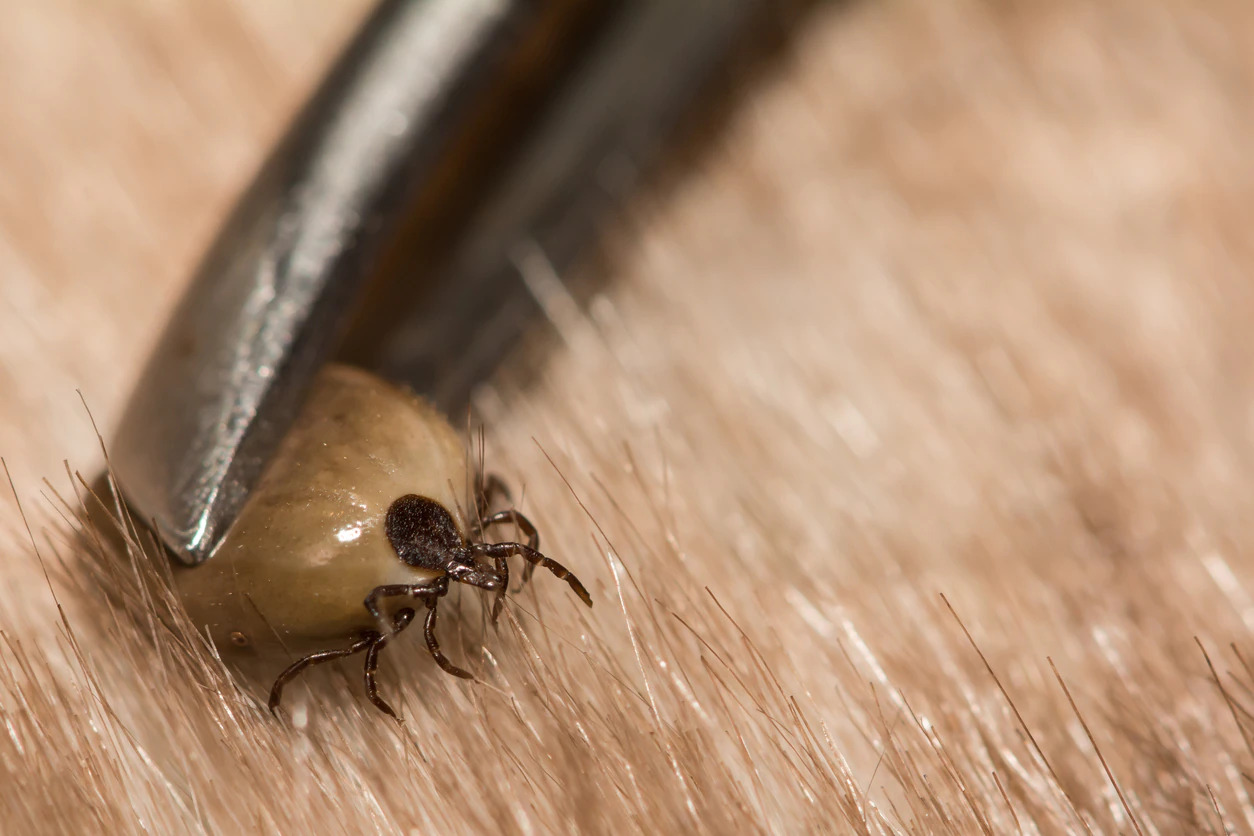Home>Health & Wellness>Common Health Issues>How Do You Know If Your Dog Has A Parasite?


Common Health Issues
How Do You Know If Your Dog Has A Parasite?
Modified: March 1, 2024
Learn about common health issues in dogs, including how to recognize if your dog has a parasite. Keep your furry friend healthy and happy!
(Many of the links in this article redirect to a specific reviewed product. Your purchase of these products through affiliate links helps to generate commission for Pawsomeoldies.com, at no extra cost. Learn more)
Table of Contents
Signs of Parasites in Dogs
Parasites are a common concern for dog owners, as these pesky organisms can cause a range of health issues for our furry friends. Being aware of the signs of parasites in dogs is crucial for early detection and prompt treatment. Here are some key indicators that your dog may be harboring parasites:
-
Changes in Appetite: Keep an eye on your dog's eating habits. A sudden increase or decrease in appetite could be a sign of a parasitic infection.
-
Weight Loss: Unexplained weight loss in your dog could be a red flag for parasites. If your dog is losing weight despite a consistent diet, it's essential to consider the possibility of parasites.
-
Visible Worms in Feces or Vomitus: One of the most obvious signs of certain parasites, such as roundworms or tapeworms, is the presence of these worms in your dog's feces or vomit.
-
Diarrhea or Vomiting: Persistent diarrhea or vomiting can indicate a parasitic infection. If these symptoms persist, it's important to seek veterinary attention.
-
Lethargy: If your dog seems unusually tired or lacks energy, it could be a sign of a parasitic infestation. Parasites can cause anemia and drain your dog's energy levels.
-
Scratching or Scooting: Excessive scratching, licking, or scooting may indicate the presence of parasites, particularly fleas or intestinal worms.
-
Visible Skin Irritation: Skin irritation, redness, or inflammation can be a sign of a parasitic infestation, such as fleas, ticks, or mites.
-
Bloody Stools: If you notice blood in your dog's stool, it could be a sign of a severe parasitic infection and requires immediate veterinary attention.
-
Coughing or Difficulty Breathing: Some parasites, such as heartworms, can affect the respiratory system, leading to coughing, wheezing, or difficulty breathing.
-
Visible Signs of Discomfort: Watch out for signs of discomfort, such as abdominal pain or restlessness, which could indicate the presence of certain parasites.
Being vigilant about these signs can help you detect and address parasitic infections in your dog promptly. If you notice any of these symptoms, it's crucial to consult with a veterinarian for proper diagnosis and treatment. Regular preventive measures, such as deworming and flea control, can also help protect your dog from parasitic infestations.
Read more: How Do You Know If Your Dog Has Anxiety
Common Types of Parasites in Dogs
Parasites are unwelcome guests that can wreak havoc on a dog's health. Understanding the common types of parasites that can affect dogs is essential for pet owners to safeguard their furry companions. Here are some prevalent parasites that can pose a threat to dogs:
1. Fleas
Fleas are among the most common external parasites found in dogs. These tiny, wingless insects feed on the blood of their hosts and can cause intense itching, skin irritation, and allergic reactions in dogs. Flea infestations can lead to dermatitis and, in severe cases, anemia, especially in young or small dogs.
2. Ticks
Ticks are another external parasite that can latch onto a dog's skin and feed on its blood. These arachnids can transmit various diseases, such as Lyme disease and Rocky Mountain spotted fever, posing a significant health risk to dogs. Prompt removal of ticks and preventive measures are crucial in protecting dogs from these parasites.
3. Roundworms
Roundworms are intestinal parasites that commonly affect dogs, especially puppies. These worms can be transmitted through the ingestion of infected feces or soil. Infections with roundworms can lead to digestive disturbances, poor growth, and, in severe cases, intestinal blockages. Regular deworming is essential to control roundworm infestations.
4. Hookworms
Hookworms are another type of intestinal parasite that can cause anemia and gastrointestinal issues in dogs. These parasites can enter a dog's body through the skin or by ingestion, and they feed on the host's blood, leading to weakness and lethargy. Preventive measures, such as maintaining clean living environments and regular deworming, are crucial in controlling hookworm infestations.
5. Heartworms
Heartworms are a serious and potentially fatal parasite transmitted through the bite of infected mosquitoes. These parasites reside in the heart, lungs, and blood vessels of infected dogs, causing severe damage to these vital organs. Prevention through regular heartworm medication is key, as treatment for heartworm disease can be complex and costly.
6. Tapeworms
Tapeworms are intestinal parasites that can be transmitted to dogs through the ingestion of infected fleas or rodents. These parasites can cause discomfort, weight loss, and irritation around the dog's anus. Effective flea control and deworming are essential in preventing tapeworm infestations.
7. Ear Mites
Ear mites are common parasites that infest the ears of dogs, leading to itching, irritation, and inflammation. These tiny mites can cause discomfort and secondary ear infections if left untreated. Regular ear examinations and prompt treatment are crucial in managing ear mite infestations.
Understanding the characteristics and potential effects of these common parasites empowers dog owners to take proactive measures in preventing and managing infestations. Regular veterinary check-ups, preventive medications, and maintaining a clean living environment are vital components of a comprehensive parasite control strategy for dogs.
Read more: How To Know If Your Dog Is Allergic To Yeast
Testing for Parasites in Dogs
Testing for parasites in dogs is a crucial aspect of maintaining their overall health and well-being. Veterinary professionals utilize various diagnostic methods to identify the presence of parasites and determine the most effective treatment strategies. Here are the primary testing approaches employed for detecting parasites in dogs:
1. Fecal Examination
Fecal examinations are commonly performed to detect the presence of intestinal parasites such as roundworms, hookworms, and whipworms. A small sample of the dog's feces is examined under a microscope to identify parasite eggs or cysts. This non-invasive test provides valuable insights into the dog's gastrointestinal health and helps in devising appropriate deworming protocols.
2. Blood Tests
Blood tests, including serological assays, are utilized to detect the presence of certain blood-borne parasites such as heartworms. These tests can identify specific antigens or antibodies associated with parasitic infections, enabling early detection and intervention. Regular screening for heartworms is essential, especially in regions where mosquito-borne diseases are prevalent.
3. Skin Scrapings
Skin scrapings are performed to diagnose external parasites such as mites, which can cause skin irritation and discomfort in dogs. A small sample of the dog's skin is collected and examined microscopically to identify the presence of mites or their eggs. This diagnostic method is crucial for addressing dermatological issues caused by parasitic infestations.
Read more: How To Know If Your Dog Is Allergic
4. Allergy Testing
In cases where flea allergy dermatitis is suspected, allergy testing may be conducted to determine the dog's sensitivity to flea bites. Identifying and addressing flea infestations is essential in managing allergic reactions and preventing secondary skin infections.
5. Heartworm Antigen Test
A heartworm antigen test is performed to detect the presence of heartworms in a dog's bloodstream. This test is particularly important for dogs residing in regions where heartworm disease is prevalent. Early detection of heartworm infections is critical for initiating appropriate treatment and preventing severe complications.
6. Diagnostic Imaging
In certain cases, diagnostic imaging techniques such as X-rays or ultrasound may be employed to assess the extent of organ damage caused by certain parasites, particularly in cases of severe heartworm infestations. These imaging studies provide valuable information for guiding treatment decisions and monitoring the dog's recovery.
Regular testing for parasites is essential for maintaining the health and well-being of dogs. By promptly identifying and addressing parasitic infestations, pet owners can ensure that their canine companions lead healthy and fulfilling lives. Collaborating with a trusted veterinarian and adhering to recommended testing protocols is fundamental in safeguarding dogs from the detrimental effects of parasitic infections.
Treatment for Parasites in Dogs
Effective treatment for parasites in dogs is essential for alleviating their discomfort and preventing potential health complications. The approach to treating parasites in dogs varies depending on the type of infestation and the specific parasite involved. Here are the primary treatment modalities utilized for addressing parasites in dogs:
1. Deworming Medications
Deworming medications are commonly prescribed to eliminate intestinal parasites such as roundworms, hookworms, and tapeworms. These medications are available in various forms, including oral tablets, chewable treats, and topical spot-on formulations. Deworming protocols are tailored based on the dog's age, weight, and potential exposure to parasites, and they are crucial for eradicating internal parasites and preventing reinfestation.
2. Flea and Tick Control Products
For dogs infested with fleas and ticks, the use of topical or oral flea control products is essential. These products effectively kill existing parasites and provide ongoing protection against reinfestation. Additionally, environmental control measures, such as treating the dog's living spaces and outdoor areas, are important for breaking the flea life cycle and preventing recurrent infestations.
3. Heartworm Treatment
Treatment for heartworm disease in dogs is more complex and typically involves a multi-step approach. In cases of mild infections, medications may be prescribed to eliminate immature heartworms and manage associated symptoms. However, severe cases may require more intensive treatment, including adulticide therapy to eliminate mature heartworms. Following treatment, dogs need to undergo a period of restricted activity to minimize the risk of complications during the recovery phase.
4. Medications for External Parasites
In cases of ear mite infestations or skin conditions caused by external parasites, veterinary-prescribed medications such as ear drops, shampoos, or topical ointments may be recommended. These medications target the specific parasites causing discomfort and help alleviate associated symptoms, such as itching and skin irritation.
Read more: What To Do If Your Dog Has Ticks
5. Supportive Care
In instances where parasitic infestations have led to secondary health issues, such as skin infections or anemia, supportive care may be necessary. This can include providing nutritional support, administering medications to address concurrent infections, and monitoring the dog's overall well-being during the recovery process.
6. Preventive Measures
Following successful treatment for parasites, implementing preventive measures is crucial for safeguarding dogs from future infestations. This includes adhering to regular deworming schedules, using flea and tick preventives as recommended, and minimizing exposure to environments where parasites are prevalent.
By employing a comprehensive treatment approach that addresses the specific parasites affecting the dog and integrating preventive strategies, pet owners can effectively manage parasitic infestations and promote the overall health and comfort of their canine companions. Collaborating closely with a veterinarian ensures that the treatment plan is tailored to the individual dog's needs, leading to successful outcomes in combating parasites and enhancing the dog's well-being.
Prevention of Parasites in Dogs
Preventing parasites in dogs is a fundamental aspect of responsible pet ownership and plays a pivotal role in maintaining the overall health and well-being of canine companions. Implementing proactive measures to prevent parasitic infestations not only safeguards the dog's health but also contributes to a harmonious and fulfilling bond between pets and their owners. Here are essential strategies for preventing parasites in dogs:
1. Regular Veterinary Check-ups
Scheduling routine veterinary examinations is crucial for monitoring the dog's health and implementing preventive measures against parasites. Veterinarians can conduct comprehensive wellness exams and recommend appropriate parasite control protocols based on the dog's lifestyle, environmental factors, and regional parasite prevalence.
2. Parasite Control Products
Utilizing veterinarian-recommended flea and tick preventives is essential for protecting dogs from external parasites. These products come in various formulations, including topical spot-on treatments, oral medications, and collars, and provide ongoing protection against fleas, ticks, and other external parasites. Regular use of these preventives helps minimize the risk of infestations and associated health issues.
3. Environmental Management
Maintaining a clean and hygienic living environment for dogs is critical in preventing parasitic infestations. Regularly cleaning and vacuuming the indoor spaces, washing the dog's bedding, and implementing environmental control measures, such as yard treatments for fleas and ticks, contribute to reducing the risk of parasite exposure.
4. Preventive Medications
Administering preventive medications for heartworms is essential, especially in regions where heartworm disease is prevalent. These medications, available in oral or topical forms, are prescribed by veterinarians and are administered on a regular schedule to protect dogs from potentially life-threatening heartworm infections.
5. Hygiene and Grooming Practices
Maintaining good hygiene and grooming practices for dogs is integral in preventing certain parasites, such as mites and fleas. Regular bathing with veterinarian-approved shampoos, thorough grooming to check for signs of parasites, and ear cleaning help minimize the risk of infestations and contribute to the dog's overall well-being.
6. Preventing Exposure to Wildlife
Minimizing the dog's exposure to wildlife, such as rodents and wild animals, helps reduce the risk of certain parasitic infections, including tapeworms. Keeping dogs on leash during outdoor activities and preventing access to areas where wildlife may be present contributes to parasite prevention.
7. Education and Awareness
Educating pet owners about the importance of parasite prevention and raising awareness about the potential risks associated with different parasites is crucial. Providing information on preventive measures, parasite life cycles, and the impact of infestations fosters a proactive approach to parasite control among dog owners.
By integrating these preventive strategies into the care routine for dogs, pet owners can significantly reduce the risk of parasitic infestations and promote the long-term health and well-being of their beloved canine companions. Collaboration with a trusted veterinarian and adherence to recommended preventive protocols are fundamental in creating a safe and healthy environment for dogs, free from the detrimental effects of parasites.








